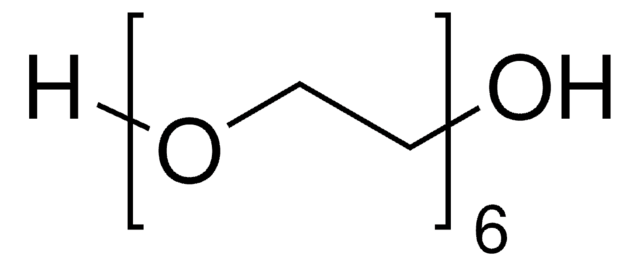689440
O-(2-Azidoethyl)heptaethylene glycol
≥95% (oligomer purity)
Synonyme(s) :
Azido-PEG (n=7)
About This Item
Produits recommandés
Niveau de qualité
Pureté
≥95% (oligomer purity)
Forme
powder
Poids mol.
average Mn 400
Capacité de réaction
reaction type: click chemistry
Pertinence de la réaction
reagent type: cross-linking reagent
Extrémité Ω
hydroxyl
Extrémité α
azide
Groupe fonctionnel
azide
hydroxyl
Température de stockage
2-8°C
Chaîne SMILES
OCCOCCOCCOCCOCCOCCOCCOCCN=[N+]=[N-]
InChI
1S/C16H33N3O8/c17-19-18-1-3-21-5-7-23-9-11-25-13-15-27-16-14-26-12-10-24-8-6-22-4-2-20/h20H,1-16H2
Clé InChI
BUMODEBRFGPXRM-UHFFFAOYSA-N
Application
Some of the reported applications include:
- Synthesis of strain-stiffening hydrogels through self-assembly of oligomers fibres derived from Azido-PEG (n=7).
- Synthesis of biodegradable tetra-PEG hydrogels for drug delivery system.
- Synthesis of heterobifunctional oligo(ethylene glycol) linkers for bioconjugation and targeted drug delivery.
- Preparation of synthetic amphiphiles for programmed pH-dependent dispersions of carbon nanotubes (CNTs).
- Selective glycoprotein detection through allosteric click-imprinting by using a self-assembled monolayer developed from the above oligomer.
- Preparation of bioactivated quantum dot micelles containing fluorescent nanocrystals.
Conditionnement
Mention d'avertissement
Warning
Mentions de danger
Conseils de prudence
Classification des risques
Eye Irrit. 2 - Skin Irrit. 2 - STOT SE 3
Organes cibles
Respiratory system
Code de la classe de stockage
10 - Combustible liquids
Classe de danger pour l'eau (WGK)
WGK 3
Point d'éclair (°F)
Not applicable
Point d'éclair (°C)
Not applicable
Équipement de protection individuelle
dust mask type N95 (US), Eyeshields, Gloves
Faites votre choix parmi les versions les plus récentes :
Déjà en possession de ce produit ?
Retrouvez la documentation relative aux produits que vous avez récemment achetés dans la Bibliothèque de documents.
Les clients ont également consulté
Articles
Progress in biotechnology fields such as tissue engineering and drug delivery is accompanied by an increasing demand for diverse functional biomaterials. One class of biomaterials that has been the subject of intense research interest is hydrogels, because they closely mimic the natural environment of cells, both chemically and physically and therefore can be used as support to grow cells. This article specifically discusses poly(ethylene glycol) (PEG) hydrogels, which are good for biological applications because they do not generally elicit an immune response. PEGs offer a readily available, easy to modify polymer for widespread use in hydrogel fabrication, including 2D and 3D scaffold for tissue culture. The degradable linkages also enable a variety of applications for release of therapeutic agents.
Devising biomaterial scaffolds that are capable of recapitulating critical aspects of the complex extracellular nature of living tissues in a threedimensional (3D) fashion is a challenging requirement in the field of tissue engineering and regenerative medicine.
Notre équipe de scientifiques dispose d'une expérience dans tous les secteurs de la recherche, notamment en sciences de la vie, science des matériaux, synthèse chimique, chromatographie, analyse et dans de nombreux autres domaines..
Contacter notre Service technique![2-[2-(2-Azidoethoxy)ethoxy]ethanol solution ~0.5 M in tert-butyl methyl ether](/deepweb/assets/sigmaaldrich/product/structures/374/007/eea7ca74-41e4-4aac-af71-c93c37ec0a5a/640/eea7ca74-41e4-4aac-af71-c93c37ec0a5a.png)




![2-[2-(2-Chloroethoxy)ethoxy]ethanol 96%](/deepweb/assets/sigmaaldrich/product/structures/902/295/ff6d7bb1-a7e0-4582-86e1-819084626e67/640/ff6d7bb1-a7e0-4582-86e1-819084626e67.png)






